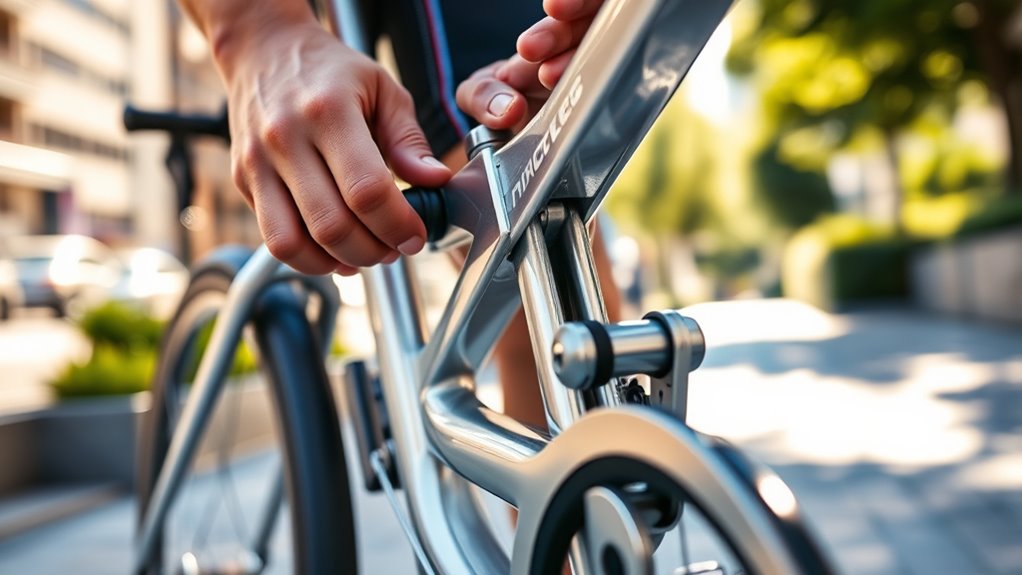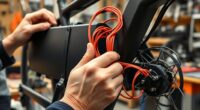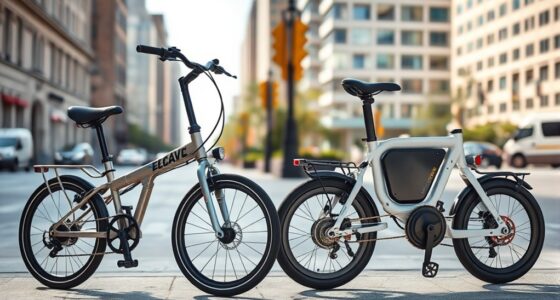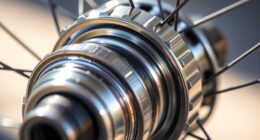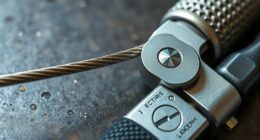To maintain your folding bike, regularly check tire pressure, inspect for cuts or wear, and keep tires properly inflated between 60-100 PSI. Clean and lubricate the chain, hinges, and moving parts to prevent rust and guarantee smooth operation. Frequently examine brake pads, cables, and the folding joints for wear or damage, replacing or adjusting as needed. Consistent upkeep keeps your bike safe and reliable, and continuing with these tips helps you extend its lifespan and performance.
Key Takeaways
- Regularly check and maintain proper tire pressure (60-100 PSI) and inspect for wear or embedded debris.
- Perform routine brake inspections; replace pads and adjust cables for optimal stopping power.
- Clean the bike thoroughly, lubricate chains, hinges, and moving parts to prevent rust and ensure smooth operation.
- Tighten loose bolts, address stuck joints, and replace worn components proactively to prevent failure.
- Store the bike in a dry environment, monitor for rust, and schedule professional tune-ups for comprehensive maintenance.
Essential Maintenance Tasks for Folding Bikes
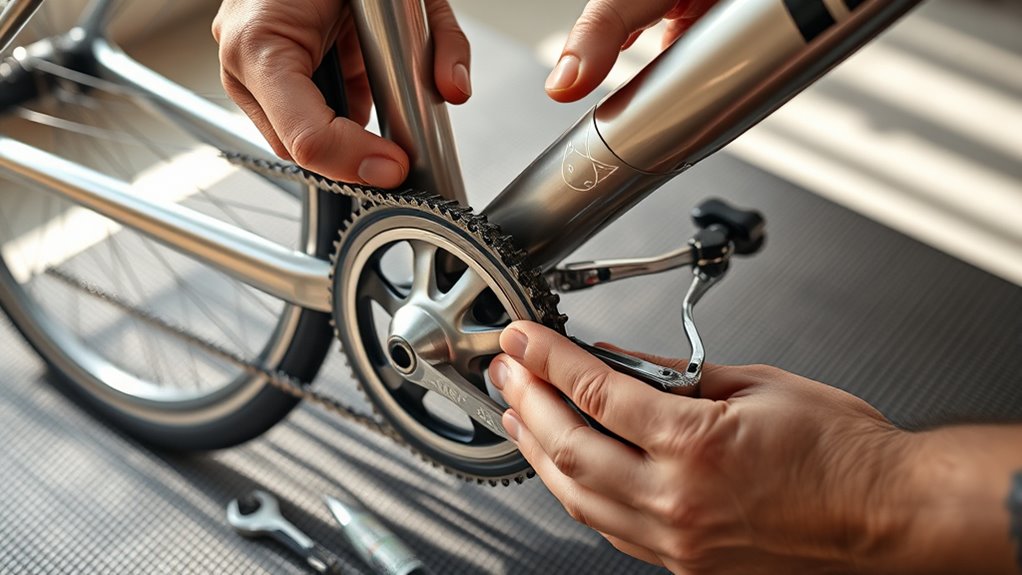
Maintaining your folding bike regularly is key to guaranteeing its longevity and reliable performance. Proper folding bike maintenance includes checking tire pressure weekly, keeping it between 60-100 PSI for smooth riding. Inspect brake pads for wear and damage, replacing them if the friction material reaches the wear indicator or braking weakens. Regular hinge inspection is essential — tighten screws, lubricate hinges, and apply lubricant to moving parts to prevent rust and ensure smooth folding and unfolding. Cleaning and lubricating the chain and other moving components with recommended lubricants help maintain ideal operation. Don’t forget to check brake levers for proper function and adjust if necessary. Consistent routine inspections, combined with storage and protection practices, keep your bike in top condition for every ride. Additionally, regularly cleaning and maintaining bike components can prevent dirt buildup and mechanical issues, ensuring optimal performance over time. Incorporating quality assurance techniques into your maintenance routine can help identify potential problems early and extend the lifespan of your bike components, particularly those related to tuning and upgrades. Using proper industry-standard tools ensures precise adjustments and helps avoid damage during maintenance. Staying informed about new safety standards can also help you adapt your maintenance practices to meet current safety requirements.
Step-by-Step Cleaning and Lubrication Procedures
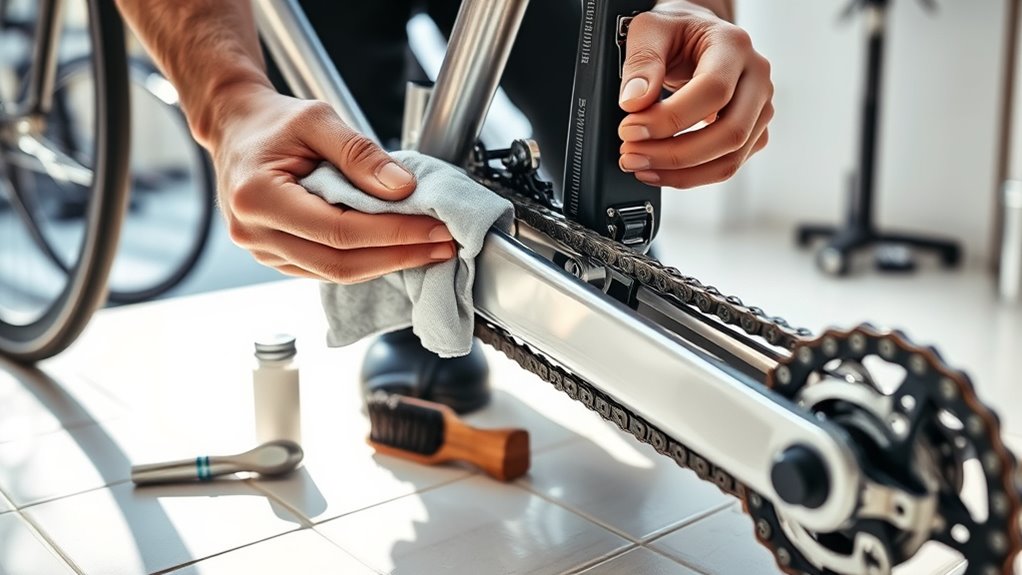
To keep your folding bike in top shape, regular cleaning and lubrication are essential. Follow this routine to ensure peak performance:
- Use a bike-specific cleaner like Bike Wash on the frame, handlebars, saddle, and rims, then wipe with a clean cloth. Applying a protective coating after cleaning can help prevent rust and corrosion. Additionally, inspecting the surface for any signs of damage or wear can help address issues early.
- Remove the chain, apply a degreaser, rinse gently, and let it dry naturally.
- Lubricate the chain evenly with a recommended lubricant such as Finish Line Wet or Dry Lube.
- Regularly clean and lubricate moving parts like hinges and joints to prevent rust and maintain smooth folding mechanics. Proper maintenance also involves inspecting components for wear and tear to address issues before they worsen.
- Incorporate Ford Tuning techniques into your maintenance routine to optimize the performance of your bike’s components and ensure longevity.
Avoid high-pressure water, which can damage bearings, hinges, and electrical components. Consistent maintenance of these areas keeps your bike functioning smoothly and prolongs its lifespan.
Inspecting and Maintaining Critical Components
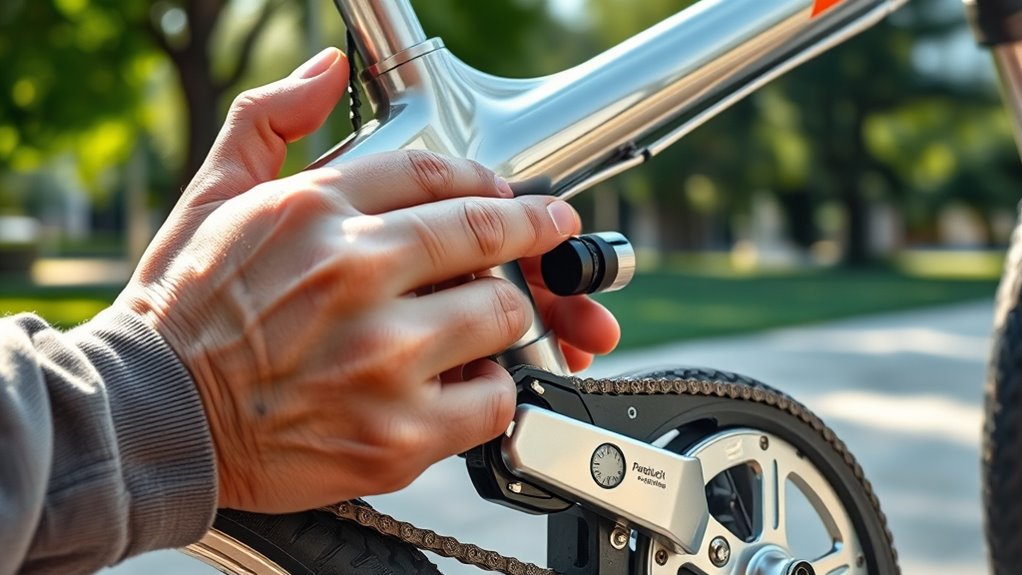
Regularly inspecting and maintaining your bike’s critical components is essential for safe and reliable riding. Start with the brakes—check the brake pads for wear, replacing them when the friction material is worn down to the indicator line to ensure effective stopping power. Examine the folding hinges and joints for looseness, rust, or stiffness; apply lubrication like synthetic motor oil to keep them operating smoothly. Inspect the chain for rust, dirt, or stiffness, and clean and lubricate it with appropriate chain lube such as Finish Line Wet or Dry Lube to prevent wear and corrosion. Check the tires for embedded debris, cuts, or tread wear, and maintain proper tire pressure within the manufacturer’s recommended PSI. Additionally, understanding the sound healing science behind vibration can inform more effective maintenance routines that optimize your bike’s performance. Incorporating rainwater capture techniques can also help maintain a clean and sustainable water source for cleaning and other uses related to bike maintenance. Staying mindful of professional maintenance practices ensures your bike remains in top condition and prolongs its lifespan. Regularly scheduling preventive maintenance can catch issues early and save costs over time. It’s also helpful to periodically test ride your bike after maintenance to ensure all components are functioning properly. Finally, verify the condition of brake and gear cables, tightening or replacing them to ensure responsive, safe riding.
Troubleshooting Common Issues and Repairs
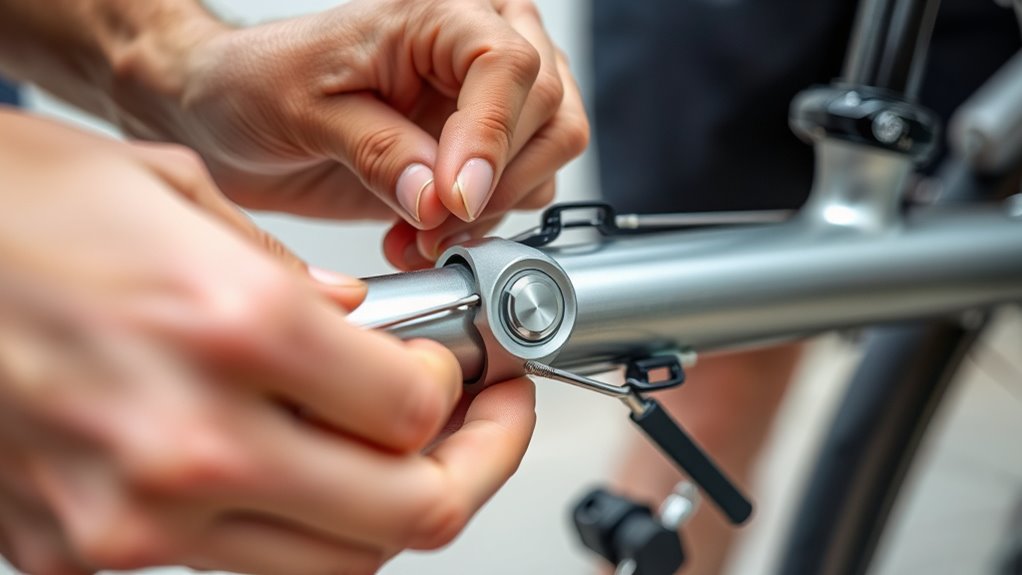
When your folding bike encounters issues like misaligned hinges, stuck joints, or loose bolts, quick troubleshooting can get you back on the road. First, check and tighten loose bolts to prevent further damage. Second, inspect moving parts and lubricate them to fix stuck joints and improve performance. Third, examine brake pads for wear, replacing them if they squeal or lose responsiveness. Fourth, review the drivetrain—worn chains, sprockets, or derailleur components can cause slipping or noise. Proper maintenance helps identify problems early, avoiding costly repairs. Regular checks and timely fixes ensure your bike functions smoothly and safely. Additionally, understanding essential oil benefits for maintenance can inspire creative ways to care for your bike’s components. Remember, addressing issues promptly keeps your bike functioning smoothly and safely. Regular checks and timely fixes ensure your folding bike remains dependable, ready for your next ride.
Tips for Extending Your Bike’s Lifespan
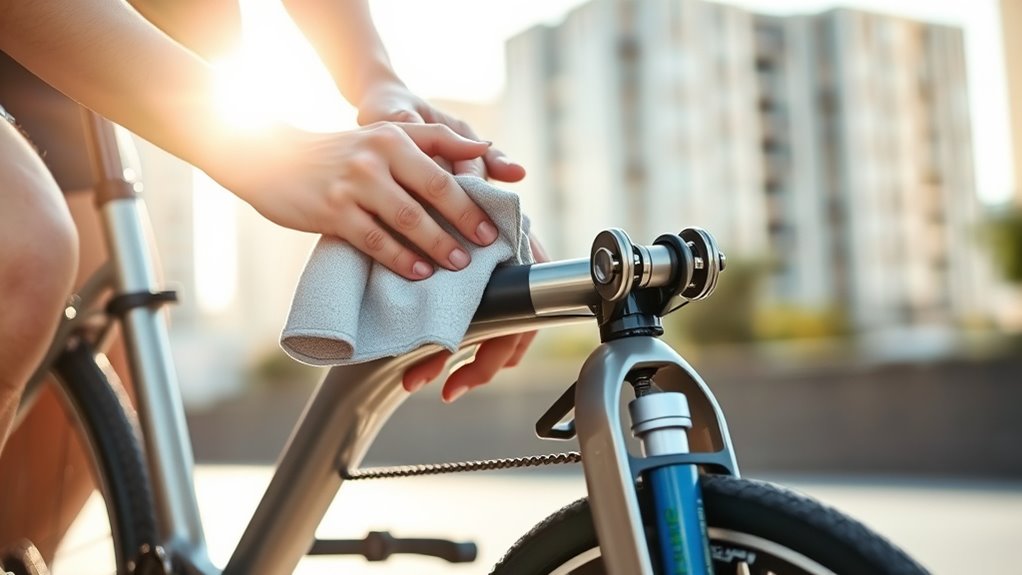
Extending your bike’s lifespan starts with simple but consistent maintenance. Keep your tires properly inflated within the recommended PSI (60-100psi) to reduce wear and prevent flats. Regularly inspect wear on brake pads and replace them promptly to maintain braking efficiency. Lubricate moving parts like chains, hinges, and gears to prevent rust and component deterioration, ensuring smooth operation. Clean your bike thoroughly and apply lubrication regularly to extend longevity. Proper storage in a dry, sheltered environment shields your bike from moisture and extreme temperatures, preventing corrosion. Schedule professional maintenance periodically to identify issues early and keep everything in top shape. Additionally, monitoring wear and damage on components helps prevent unexpected failures and extends your bike’s overall lifespan. Being aware of affairs and other digital interactions can help you maintain trust and prevent emotional disruptions that might affect your focus on bike care. Regularly checking for rust or corrosion and addressing it promptly also contributes to maintaining your bike’s condition. Incorporating preventive measures such as using protective covers or rust inhibitors can further safeguard your bike from environmental damage. Staying informed about credit card insights and other personal finance topics can help you better manage your expenses related to bike maintenance and upgrades. By following these tips—monitoring tire pressure, performing brake maintenance, and maintaining your bike—you’ll considerably prolong its functional life.
Frequently Asked Questions
How to Maintain a Foldable Bike?
To keep your foldable bike in top shape, you should clean it regularly with gentle bike wash and degreaser, avoiding high-pressure water. Lubricate the chain and moving parts after cleaning, and check brake pads, tires, and gears for wear or damage. Make sure your tires are inflated to the recommended PSI, and do safety checks like brake response, wheel alignment, and lights before every ride.
What Is the Disadvantage of a Folding Bike?
Like a ship with a fragile hull, a folding bike’s main disadvantage is its reduced stability and durability. You might find it less comfortable on rough terrain, and its hinges could wear out quicker over time. Its lighter, more intricate design sacrifices some strength and performance, making it more prone to damage. Ultimately, while convenient, it requires extra care to guarantee it remains reliable on your journeys.
What Is the Best Folding Bike for the Money?
When choosing the best folding bike for the money, consider your needs and budget. The Dahon Mariner D8 offers great value with lightweight construction and 8-speed gearing, perfect for everyday commuting. If you want premium quality and compactness, the Brompton M6L is a solid investment. For electric assistance, the Tern Vektron S10 provides power and convenience. Evaluate your priorities to find the best fit without overspending.
What Maintenance Should I Do on My Bike?
You might find it surprising, but regular maintenance keeps your bike running smoothly. You should clean and lubricate the chain, inspect brake pads, and check tire pressure weekly. Tighten loose bolts, especially on hinges and handlebars, and give moving parts a good lubricant. Before every ride, do a quick safety check on lights, brakes, and gears. These simple steps prevent issues and make certain your bike stays reliable and safe.
Conclusion
By staying on top of regular maintenance, you’ll keep your folding bike running smoothly and avoid costly repairs down the road. Remember, a stitch in time saves nine—taking small steps now can prevent bigger headaches later. Keep your bike clean, lubricated, and checked regularly, and it’ll serve you well for miles to come. With consistent care, your trusty ride will be ready to roll whenever you are, proving that the early bird catches the worm.
